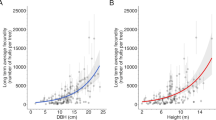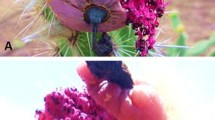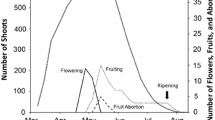Abstract
The reproductive success of animal-dispersed plants is closely linked to the number of seeds that they are able to disperse. The fruit crop size hypothesis states that a plant with large fruit crop size will attract more dispersers than a plant with a smaller fruit crop, which may result in more seeds being dispersed from the foremost. In this study, we experimentally examined the effect of crop size and other factors on primary seed dispersal in a neotropical shrub/tree, Casearia corymbosa (Flacourtiaceae). We used two predictive variables of reproductive success, which produce an accurate picture of seed dispersal ratio: fruit removal efficiency (proportion of a fruit crop removed by frugivores) and fruit removal success (relative contribution of each individual tree to the number of fruits removed in the population). We established two levels of fruit crop size at the C. corymbosa individuals, using plants with large (150 fruits) and small crops (50 fruits). We found that individual plants with larger crops had significantly higher values of fruit removal efficiency (92.6%) and success (5%) than plants with smaller crops (69.3% and 1.3%, respectively). Fruit removal efficiency was related to vegetation type, plant height and fruit width, but the variance explained by these variables was low ( < 8%). Fruit removal success was significantly related to crop size ( > 90% of the variance explained). These results suggest that fruit removal efficiency and success are strongly related to fruit crop size of C. corymbosa plants.
Similar content being viewed by others
References
Alcántara JM, Rey PJ, Valera F, Sánchez-Lafuente AM, Gutiérrez JE (1997) Habitat alteration and plant intra-specific competition for seed dispersers. An example with Olea europaea var. sylvestris. Oikos 79:291–300
Albores YV (2001) Efecto del tamaño de cosecha y vegetación circundante de Casearia corymbosa (Flacourtiaceae) en la visita de aves y dispersión de sus semillas. Bachelor thesis. Universidad de las Américas-Puebla. Cholula, Puebla, México
Borgmann KL, Pearson SF, Levey DJ, Greenberg CH (2004) Wintering Yellow-rumped Warblers (Dendroica coronata) track manipulated abundance of Myrica cerifera fruits. Auk 121:74–87
Capistrán-Barradas A, Defeo O, Moreno-Casasola P (2003) Density and population structure of the red land crab Gecarcinus lateralis in a tropical semi-deciduous forest in Veracruz, Mexico. Interciencia 28:323–327
Courtney SP, Manzur MI (1985) Fruiting and fitness in Crataegus monogyna: the effect of frugivores and seed predators. Oikos 44:398–406
Crawley MJ (1993) GLIM for ecologists. Blackwell Scientific Publications, Oxford, U.K
Delfosse B (1992) The effect of the red land crab Gecarcinus lateralis on the litter and nutrient cycling of a coastal semi-deciduous tropical forest. M. S. thesis. York University, Toronto, Canada
Denslow JS (1987) Fruit removal rates from aggregated and isolated bushes of the red elderberry, Sambucus pubens. Can J Bot 65:1229–1235
Denslow JS, Moermond TC, Levey DJ (1986) Spatial components of fruit display in understory trees and shrubs. In: Estrada A, Fleming TH (eds), Frugivores and seed dispersal. Dr. W. Junk Publishers, Dordrecht, The Netherlands, pp 37–44
Foster MS (1990) Factors influencing bird foraging preferences among conspecific fruit trees. Condor 92:844–854
Francis B, Green M, Payne C (1993) The GLIM system, release 4 manual. Clarendon Press, Oxford, UK
García D, Ortiz-Pulido R (2004) Patterns of resource tracking by avian frugivores at multiple scales: two case studies on discordance among scales. Ecography 27:187–196
García-Franco JG, Rico-Gray V, Zayas O (1991) Seed and seedling predation of Bromelia pinguin L. by the red land crab Gecarcinus lateralis Frem. In Veracruz, Mexico. Biotropica 23:96–97
Herrera CM, Jordano P, López-Soria L, Amat JA (1994) Recruitment of a mast-fruiting, bird-dispersed tree: bridging frugivore activity and seedling establishment. Ecol Monogr 64:315–344
Howe HF (1977) Bird activity and seed dispersal of a tropical wet forest tree. Ecology 58:539–550
Howe HF (1979) Fear and frugivory. Am Nat 114:925–931
Howe HF, Estabrook GF (1977) On intraspecific competition for avian dispersers in tropical trees. Am Nat 111:817–832
Howe HF, vande Kerckhove G (1979) Fecundity and seed dispersal of a tropical tree. Ecology 60:180–189
Jordano P (1987) Avian fruit removal: effects of fruit variation, crop size, and insect damage. Ecology 68:711–1723
Jordano P (1995) Frugivore-mediated selection on fruit and seed size: birds and St. Lucie’s cherry, Prunus mahaleb. Ecology 76:2627–2639
Jordano P, Schupp EW (2000) Seed disperser effectiveness: the quantity component and patterns of seed rain for Prunus mahaleb. Ecol Monogr 70:591–615
Laska MS, Stiles EW (1994). Effects of fruit crop size on intensity of fruit removal in Viburnum prunifolium (Caprifoliaceae). Oikos 69:199–202
Manasse RS, Howe HF (1983) Competition for dispersal agents among tropical trees: influences of neighbors. Oecologia 59:185–190
Manzur MI, Courtney SP (1984) Influence of insect damage in fruits of hawthorn on bird foraging and seed dispersal. Oikos 43:265–270
Mazer SJ, Wheelwright NT (1993) Fruit size and shape: allometry at different taxonomic levels in bird-dispersed plants. Evol Ecol 7:556–575
McKey D (1975) The ecology of coevolved seed dispersal systems. In: Gilbert LE, Raven PH (eds), Coevolution of animals an plants. University of Texas Press, Texas, USA, pp 159–191
Moegenburg SM, Levey DJ (2003) Do frugivores respond to fruit harvest? An experimental study of short-term responses. Ecology 84:2600–2612
Murray KG (1987) Selection for optimal fruit-crop size in bird-dispersed plants. Am Nat 129:18–31
Nee M (1999) Flora de Veracruz: Flacourtiaceae. Fascículo 111. Instituto de Ecología A.C. and University of California. Xalapa, Veracruz, México
Novelo RA (1978) La vegetación de la Estación Biológica El Morro de La Mancha, Veracruz. Biotica (México) 3:9–23
Ortiz-Pulido R (1994) Frugivoría y dispersión de semillas por aves en el Morro de La Mancha, Ver. Bachelor Thesis. Universidad Veracruzana. Xalapa, Veracruz, México
Ortiz-Pulido R (2000) Abundance of frugivorous birds and richness of fruit resource: is there a temporal relationship?. Caldasia 22:93–107
Ortiz-Pulido R, Rico-Gray V (2000) The effect of spatio-temporal variation in understanding the fruit crop size hypothesis. Oikos 91:523–527
Ortiz-Pulido R, Laborde J, Guevara S (2000) Frugivoría por aves en un paisaje fragmentado: consecuencias en la dispersión de semillas. Biotropica 32:473–488
Pratt TK, Stiles EW (1985) The influence of fruit size and structure on composition of frugivore assemblages in New Guinea. Biotropica 17:314–321
Sallabanks R (1992) Fruit fate, frugivory, and fruit characteristics: a study of the hawthorn, Crataegus monogyna (Rosaceae). Oecologia 91:296–304
Sallabanks R (1993) Hierarchical mechanisms of fruit selection by an avian frugivore. Ecology 74:1326–1336
Sallabanks R, Courtney SP (1993) On fruit-frugivore relationships: variety is the spice of life. Oikos 68:567–570
Sargent S (1990) Neighborhood effects on fruit removal by birds: a field experiment with Viburnum dentatum (Caprifoliaceae). Ecology 71:1289–1298
Schupp EW (1993) Quantity, quality and the effectiveness of seed dispersal by animals. Vegetatio 107/108:12–29
Snow DW (1971) Evolutionary aspects of fruit-eating by birds. Ibis 113:194–202
Thébaud C, Debussche M (1992) A field test of the effects of infructescence size on fruit removal by birds in Viburnum tinus. Oikos 65:391–394
Traveset A (1994) Influence of avian frugivory on the fitness of Pistacia terebinthus L. Evol Ecol 8:618–627
Willson MF, Whelan CJ (1993) Variation of dispersal phenology in a bird-dispersed shrub, Cornus drummondii. Ecol Monogr 63:151–172
Wiens JA (1989) Spatial scaling in ecology. Funct Ecol 3:385–397
Acknowledgements
To Alejandro Cordoba-Aguilar whose help was essential at several stages of this research. We thank Douglas Levey, Daniel Garcia, Russell Greenberg, Marco Aurelio Pizo and Truman P. Young for critical reviews of earlier versions of this paper; the Instituto de Ecología A.C, especially Enrique Barradas, for allowing us to conduct fieldwork at CICOLMA, and Carlos Duran for plant determination; David Gernandt for reviewing the English version of the manuscript; and Sigma Xi for financially supporting of Y. V. Albores.
Author information
Authors and Affiliations
Corresponding author
Rights and permissions
About this article
Cite this article
Ortiz-Pulido, R., Albores-Barajas, Y.V. & Díaz, S.A. Fruit removal efficiency and success: influence of crop size in a neotropical treelet. Plant Ecol 189, 147–154 (2007). https://doi.org/10.1007/s11258-006-9175-7
Received:
Accepted:
Published:
Issue Date:
DOI: https://doi.org/10.1007/s11258-006-9175-7




